Preliminary Prediction of the Increase in Flood Hazard from Wind Surges for the City of Elbląg Due to Climate Change †
Abstract
Featured Application
Abstract
1. Introduction
1.1. Flood Hazard in the City of Elbląg
1.2. Impact of Climate Change on Wind
1.3. Applications of the HEC-RAS Model
1.4. Research Objectives
2. Materials and Methods
2.1. Study Area
2.2. HEC-RAS Hydrodynamic Mathematical Model
- t—time (s);
- u, v—velocity components in x and y directions (m·s−1);
- q—source/sink flux term (m3·s−1·m−2);
- H—water surface elevation (m asl);
- h—water depth (m);
- g—gravitational acceleration (m·s−2);
- vt—horizontal eddy viscosity coefficient (m2·s−1);
- cf—bottom friction coefficient (-);
- f—Coriolis parameter (s−1);
3. Results and Discussion
3.1. Historical Storm Surge Event, January 2019
3.1.1. Meteorological Conditions and Situation in the Gulf of Gdańsk
3.1.2. Impact on the Vistula Lagoon
3.1.3. Correlation Between Sea Level, Wind Parameters and Storm Surge in the Lagoon
3.1.4. Numerical Simulation
3.1.5. HEC-RAS Model Validation
3.2. Synthetic Wind Surge Epizodes
4. Conclusions, Limitations and Future Research
4.1. Conclusions
- The historical storm surge event of January 2019 was successfully reproduced using the HEC-RAS 2D model, validating its applicability for simulating wind-induced water level changes in shallow lagoons;
- The numerical simulations of synthetic extreme wind scenarios showed that water levels in the lagoon could exceed 3 m above sea level when wind speeds reach 35 ms−1, significantly surpassing flood warning and alarm thresholds;
- A non-linear relationship was observed between wind speed and water accumulation, indicating that even moderate increases in storm intensity could lead to disproportionately higher flood hazards.
4.2. Limitations
- Simplified wind representation. The simulations assumed a time-invariant and spatially uniform wind field over the lagoon, whereas in reality, wind characteristics are unsteady and may vary locally, influencing surge dynamics in a more complex manner.
- Neglect of additional hydrological inputs. The study focused primarily on wind-driven surges, without considering the potential contribution of river inflows, precipitation, or ice cover effects, which may also influence water levels.
- Static sea level assumption. The boundary conditions did not incorporate a projected long-term sea level rise due to climate change, which could exacerbate future flood hazards.
4.3. Future Research Directions
- Integration of dynamic climate projections. The latest IPCC-based climate models to refine predictions of wind intensification and sea level rise effects should be incorporated.
- Coupling wind surge and precipitation-driven flooding. Compound flooding scenarios in the city of Elbląg that combine storm surges, extreme rainfall, and riverine floods should be investigated.
- Adaptation and mitigation strategies. The effectiveness of potential flood protection measures, such as storm barriers, retention restoration, and improved drainage infrastructure should be assessed.
Author Contributions
Funding
Institutional Review Board Statement
Informed Consent Statement
Data Availability Statement
Conflicts of Interest
Abbreviations
| SWE | Shallow water equations |
| IMGW-PIB | Polish Institute of Meteorology and Water Management |
| HEC-RAS | Hydrologic Engineering Center’s River Analysis System |
References
- Chubarenko, B.; Margoński, P. The Vistula Lagoon. In Ecology of Baltic Coastal Waters; Schiewer, U., Ed.; Ecological Studies; Springer: Berlin/Heidelberg, Germany, 2008; pp. 167–195. ISBN 978-3-540-73524-3. [Google Scholar]
- Cieśliński, R.; Chlost, I. Water Balance Characteristics of the Vistula Lagoon Coastal Area along the Southern Baltic Sea. Baltica 2017, 30, 107–117. [Google Scholar] [CrossRef]
- Szymkiewicz, R. Hydrodynamics of Vistula Lagoon. Monography of P.A.S.: Warsaw, Poland, 1992. [Google Scholar]
- Łazarenko, N.N.; Majewski, A. Hydrometeorological System of the Vistula Lagoon; Communication Publishing House: Warsaw, Poland, 1975. [Google Scholar]
- Szydłowski, M.; Artichowicz, W.; Zima, P. Analysis of the Water Level Variation in the Polish Part of the Vistula Lagoon (Baltic Sea) and Estimation of Water Inflow and Outflow Transport through the Strait of Baltiysk in the Years 2008–2017. Water 2021, 13, 1328. [Google Scholar] [CrossRef]
- Szymkiewicz, R. A Mathematical Model of Storm Surge in the Vistula Lagoon, Poland. Coast. Eng. 1992, 16, 181–203. [Google Scholar] [CrossRef]
- Kolerski, T.; Zima, P.; Szydłowski, M. Mathematical Modeling of Ice Thrusting on the Shore of the Vistula Lagoon (Baltic Sea) and the Proposed Artificial Island. Water 2019, 11, 2297. [Google Scholar] [CrossRef]
- Konieczny, R.; Pińskwar, I.; Kundzewicz, Z. The September 2017 Flood in Elbląg (Poland) in Perspective. Meteorol. Hydrol. Water Manag. 2018, 6, 67–78. [Google Scholar] [CrossRef]
- Topiłko, J. Modeling Storm Surge Floods—Case Study Żuławy Elbląskie—Obserwator IMGW-PIB 2021. Available online: https://obserwator.imgw.pl/2021/10/21/modeling-storm-surge-floods-case-study-zulawy-elblaskie/ (accessed on 30 January 2025).
- Kistowski, M. Strategic Planning of Flood Protection: A Case Study of „Programme for Żuławy Region—To 2030 Complex Flood Protection”. In Issues of Landscape Conservation and Water Management in Rural Areas; Contemporary Problems of Management and Environmental Protection; University of Warmia and Mazury: Olsztyn, Poland, 2011; Volume 7, pp. 221–231. [Google Scholar]
- Szydłowski, M.; Kolerski, T.; Zima, P. Impact of the Artificial Strait in the Vistula Spit on the Hydrodynamics of the Vistula Lagoon (Baltic Sea). Water 2019, 11, 990. [Google Scholar] [CrossRef]
- IMGW-PIB Map Hydro. Available online: https://hydro.imgw.pl (accessed on 30 January 2025).
- Outten, S.; Sobolowski, S. Extreme Wind Projections over Europe from the Euro-CORDEX Regional Climate Models. Weather Clim. Extrem. 2021, 33, 100363. [Google Scholar] [CrossRef]
- Forzieri, G.; Feyen, L.; Russo, S.; Vousdoukas, M.; Alfieri, L.; Outten, S.; Migliavacca, M.; Bianchi, A.; Rojas, R.; Cid, A. Multi-Hazard Assessment in Europe under Climate Change. Clim. Chang. 2016, 137, 105–119. [Google Scholar] [CrossRef]
- Busker, T.; van den Hurk, B.; de Moel, H.; Aerts, J.C.J.H. The Value of Precipitation Forecasts to Anticipate Floods. Bull. Am. Meteorol. Soc. 2025, 106, E473–E491. [Google Scholar] [CrossRef]
- NatCatSERVICE|Munich Re. Available online: https://www.munichre.com/en/solutions/for-industry-clients/natcatservice.html (accessed on 17 March 2025).
- Kjellström, E.; Nikulin, G.; Hansson, U.; Strandberg, G.; Ullerstig, A. 21st Century Changes in the European Climate: Uncertainties Derived from an Ensemble of Regional Climate Model Simulations. Tellus A Dyn. Meteorol. Oceanogr. 2011, 63, 24–40. [Google Scholar] [CrossRef]
- Intergovernmental Panel On Climate Change (IPCC). Climate Change 2021—The Physical Science Basis: Working Group I Contribution to the Sixth Assessment Report of the Intergovernmental Panel on Climate Change, 1st ed.; Cambridge University Press: Cambridge, UK, 2023; ISBN 978-1-00-915789-6. [Google Scholar]
- Little, A.S.; Priestley, M.D.K.; Catto, J.L. Future Increased Risk from Extratropical Windstorms in Northern Europe. Nat. Commun. 2023, 14, 4434. [Google Scholar] [CrossRef] [PubMed]
- Rasool, S.I.; Menenti, M.; Bolle, H.-J. Second Assessment of Climate Change for the Baltic Sea Basin; Springer: Berlin/Heidelberg, Germany, 2015; ISBN 978-3-319-16005-4. [Google Scholar]
- Donat, M.G.; Leckebusch, G.C.; Wild, S.; Ulbrich, U. Future Changes in European Winter Storm Losses and Extreme Wind Speeds Inferred from GCM and RCM Multi-Model Simulations. Nat. Hazards Earth Syst. Sci. 2011, 11, 1351–1370. [Google Scholar] [CrossRef]
- Nikulin, G.; Kjellström, E.; Hansson, U.; Strandberg, G.; Ullerstig, A. Evaluation and Future Projections of Temperature, Precipitation and Wind Extremes over Europe in an Ensemble of Regional Climate Simulations. Tellus A Dyn. Meteorol. Oceanogr. 2011, 63, 41–55. [Google Scholar] [CrossRef]
- Meier, H.E.M.; Kniebusch, M.; Dieterich, C.; Gröger, M.; Zorita, E.; Elmgren, R.; Myrberg, K.; Ahola, M.P.; Bartosova, A.; Bonsdorff, E.; et al. Climate Change in the Baltic Sea Region: A Summary. Earth Syst. Dyn. 2022, 13, 457–593. [Google Scholar] [CrossRef]
- Brunner, G.W. HEC-RAS River Analysis System 2D Modeling User’s Manual; US Army Corps of Engineers—Hydrologic Engineering Center: Davis, CA, USA, 2016. [Google Scholar]
- Amaliah, R.; Ginting, B.M. Investigating the Capability of HEC-RAS Model for Tsunami Simulation. J. Civ. Eng. Forum 2023, 9, 161–180. [Google Scholar] [CrossRef]
- Costabile, P.; Costanzo, C.; Ferraro, D.; Macchione, F.; Petaccia, G. Performances of the New HEC-RAS Version 5 for 2-D Hydrodynamic-Based Rainfall-Runoff Simulations at Basin Scale: Comparison with a State-of-the Art Model. Water 2020, 12, 2326. [Google Scholar] [CrossRef]
- Saini, D.S.; Barik, D.K. Simulation of the Hydraulic Model HEC-RAS Coupled with GIS and Remote Sensing to Study the Effect of River Cross-Section Width in Detecting Flood-Prone Areas. J. Geol. Soc. India 2024, 100, 367–376. [Google Scholar] [CrossRef]
- Shaikh, A.A.; Pathan, A.I.; Waikhom, S.I.; Agnihotri, P.G.; Islam, M.d.N.; Singh, S.K. Application of Latest HEC-RAS Version 6 for 2D Hydrodynamic Modeling through GIS Framework: A Case Study from Coastal Urban Floodplain in India. Model. Earth Syst. Environ. 2023, 9, 1369–1385. [Google Scholar] [CrossRef]
- Alia, F.; Rendana, M.; Idris, W.M.R.; Sarino, S.; Yuono, A.L. Flood Mapping Using HEC-RAS and GIS: A Case Study of Palembang Watersheds. J. Adv. Res. Appl. Sci. Eng. Technol. 2024, 61, 138–150. [Google Scholar] [CrossRef]
- Amoussou, E.; Amoussou, F.T.; Bossa, A.Y.; Kodja, D.J.; Totin Vodounon, H.S.; Houndénou, C.; Borrell Estupina, V.; Paturel, J.-E.; Mahé, G.; Cudennec, C.; et al. Use of the HEC RAS Model for the Analysis of Exceptional Floods in the Ouémé Basin. Proc. IAHS 2024, 385, 141–146. [Google Scholar] [CrossRef]
- Latif, F.; Hakim, A. Utilization of hec-ras 2d for flood influence modeling due to peak discharge of walanae river in wajo district. J. Inform. Dan Tek. Elektro Terap. 2025, 13, 1529–1539. [Google Scholar] [CrossRef]
- Milišić, H.; Hadžić, E. Estimation of Channel and Flood Plain Roughness Using HEC-RAS Model: A Case Study of the Veseočica River, Bosnia and Herzegovina. IOP Conf. Ser. Mater. Sci. Eng. 2023, 1298, 012031. [Google Scholar] [CrossRef]
- Zeiger, S.J.; Hubbart, J.A. Measuring and Modeling Event-Based Environmental Flows: An Assessment of HEC-RAS 2D Rain-on-Grid Simulations. J. Environ. Manag. 2021, 285, 112125. [Google Scholar] [CrossRef] [PubMed]
- Muñoz, D.F.; Yin, D.; Bakhtyar, R.; Moftakhari, H.; Xue, Z.; Mandli, K.; Ferreira, C. Inter-Model Comparison of Delft3D-FM and 2D HEC-RAS for Total Water Level Prediction in Coastal to Inland Transition Zones. JAWRA J. Am. Water Resour. Assoc. 2022, 58, 34–49. [Google Scholar] [CrossRef]
- Pandey, S.; Rao, A.D.; Haldar, R. Modeling of Coastal Inundation in Response to a Tropical Cyclone Using a Coupled Hydraulic HEC-RAS and ADCIRC Model. J. Geophys. Res. Ocean. 2021, 126, e2020JC016810. [Google Scholar] [CrossRef]
- Szydłowski, M. Wind Surge Modeling in the Vistula Lagoon Using HEC-RAS 2D—Today’s and Tomorrow’s Perspective. In Proceedings of the XLII International School of Hydraulics, Radocza, Poland, 20–23 May 2025. [Google Scholar]
- Cieśliński, R.; Chlost, I.; Szydłowski, M. Impact of New, Navigable Canal through the Vistula Spit on the Hydrologic Balance of the Vistula Lagoon (Baltic Sea). J. Mar. Syst. 2024, 241, 103908. [Google Scholar] [CrossRef]
- Chubarenko, B.V.; Zakirov, R.B. Water Exchange of Nontidal Estuarine Coastal Vistula Lagoon with the Baltic Sea. J. Waterw. Port Coast. Ocean Eng. 2021, 147, 05021005. [Google Scholar] [CrossRef]
- Breś, J.; Lorens, P. Shaping the New Vistula Spit Channel: Political, Economic, and Environmental Aspects. Urban Plan. 2023, 8, 275–288. [Google Scholar] [CrossRef]
- Szydłowski, M.; Kolerski, T. Hydrodynamic Model of the New Waterway through the Vistula Spit. Pol. Marit. Res. 2020, 27, 159–167. [Google Scholar] [CrossRef]
- Cieśliński, R.; Lewandowski, A. Hydrological regime of the Vistula Lagoon and the possible changes due to the construction of the waterway connecting the Vistula Bay with the Gulf of Gdansk. Inżynieria Morska I Geotech. 2013, 1, 69–78. [Google Scholar]
- Bielecka, M.; Kazmierski, J. A 3d Mathematical Model of Vistula Lagoon Hydrodynamics—General Assumptions and Results of Preliminary Calculations. Ground Water 2003, 80, 2–4. [Google Scholar]
- Fourniotis, N.T.; Horsch, G.M.; Leftheriotis, G.A. On the Hydrodynamic Geometry of Flow-Through versus Restricted Lagoons. Water 2018, 10, 237. [Google Scholar] [CrossRef]
- Fourniotis, N.T.; Leftheriotis, G.A.; Horsch, G.M. Towards Enhancing Tidally-Induced Water Renewal in Coastal Lagoons. Environ. Fluid Mech. 2021, 21, 343–360. [Google Scholar] [CrossRef]
- Hsu, S.-A. Coastal Meteorology; Academic Press Inc.: San Diego, California, USA, 1988; ISBN 978-0-08-050215-1. [Google Scholar]
- Tan, W. Shallow Water Hydrodynamics; Elsevier Science: Amsterdam, The Netherlands, 1992. [Google Scholar]
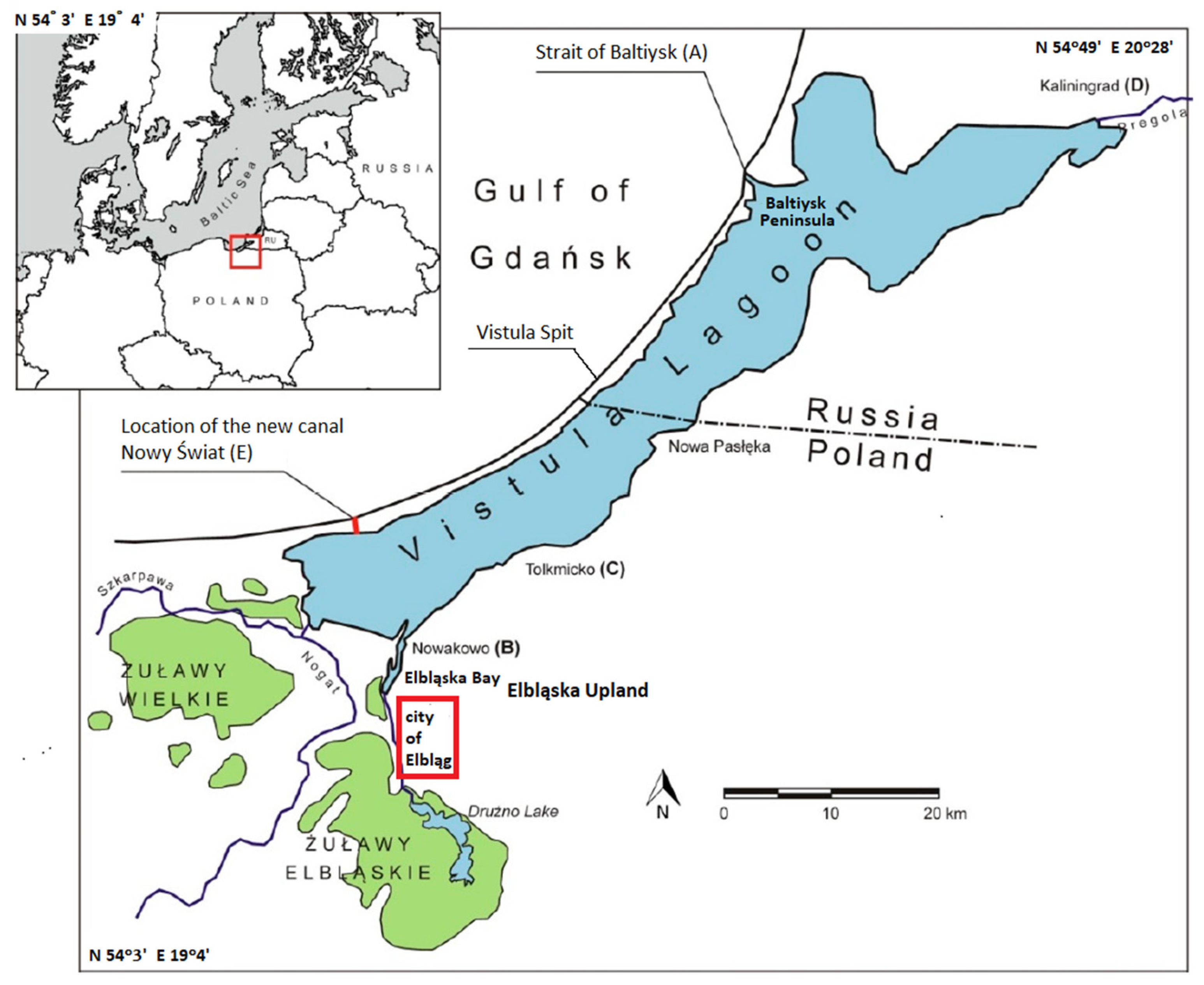
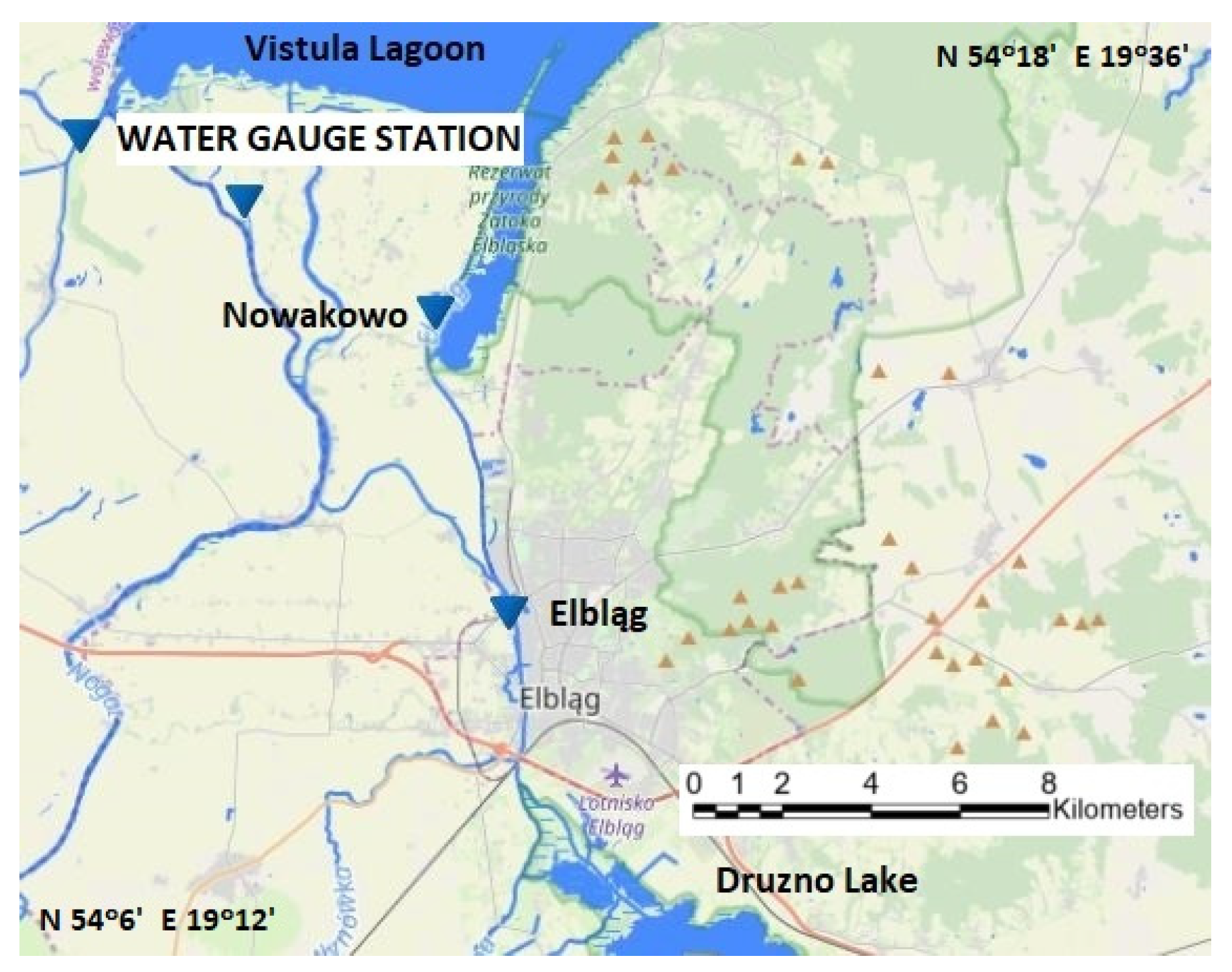


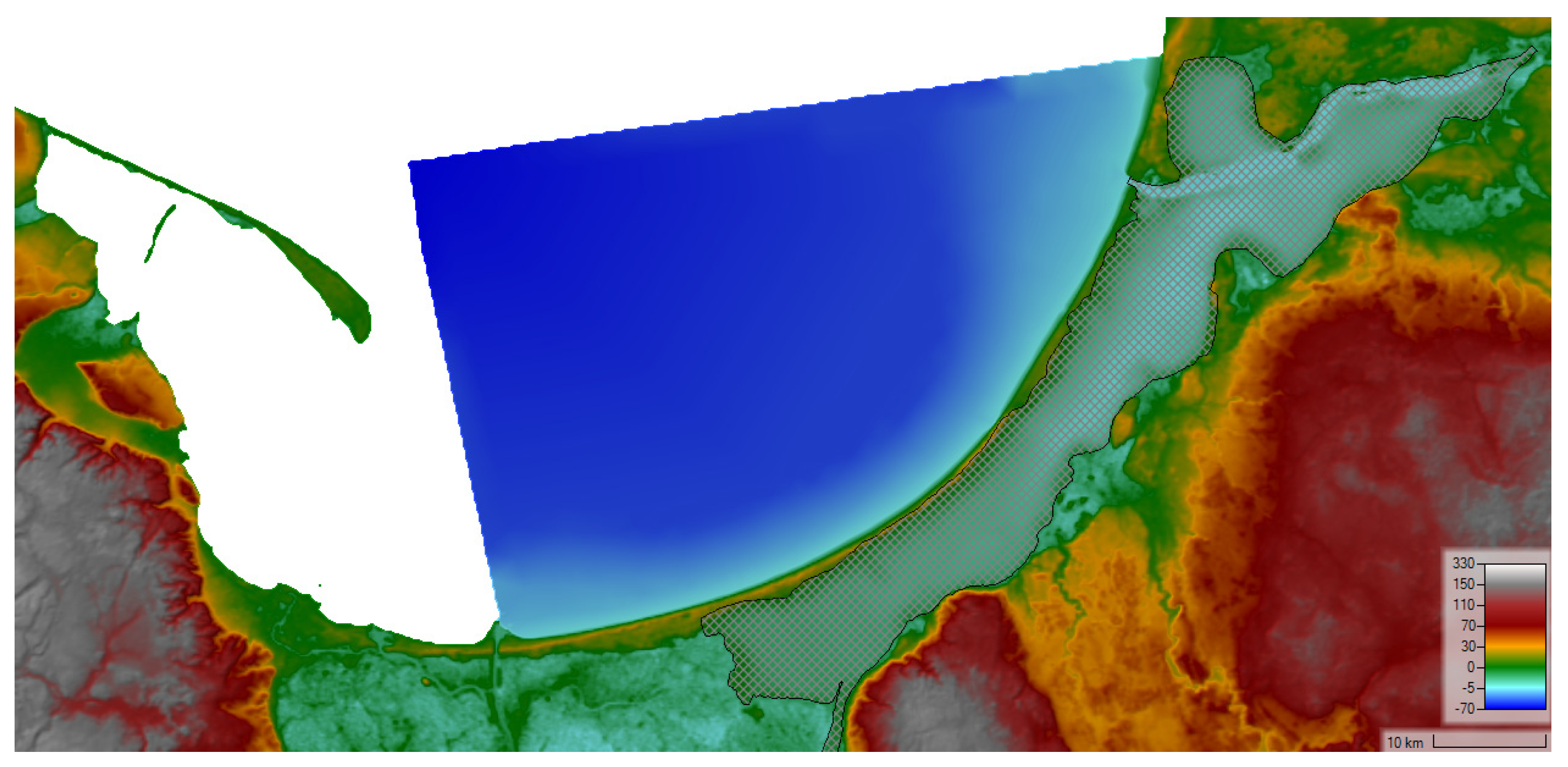
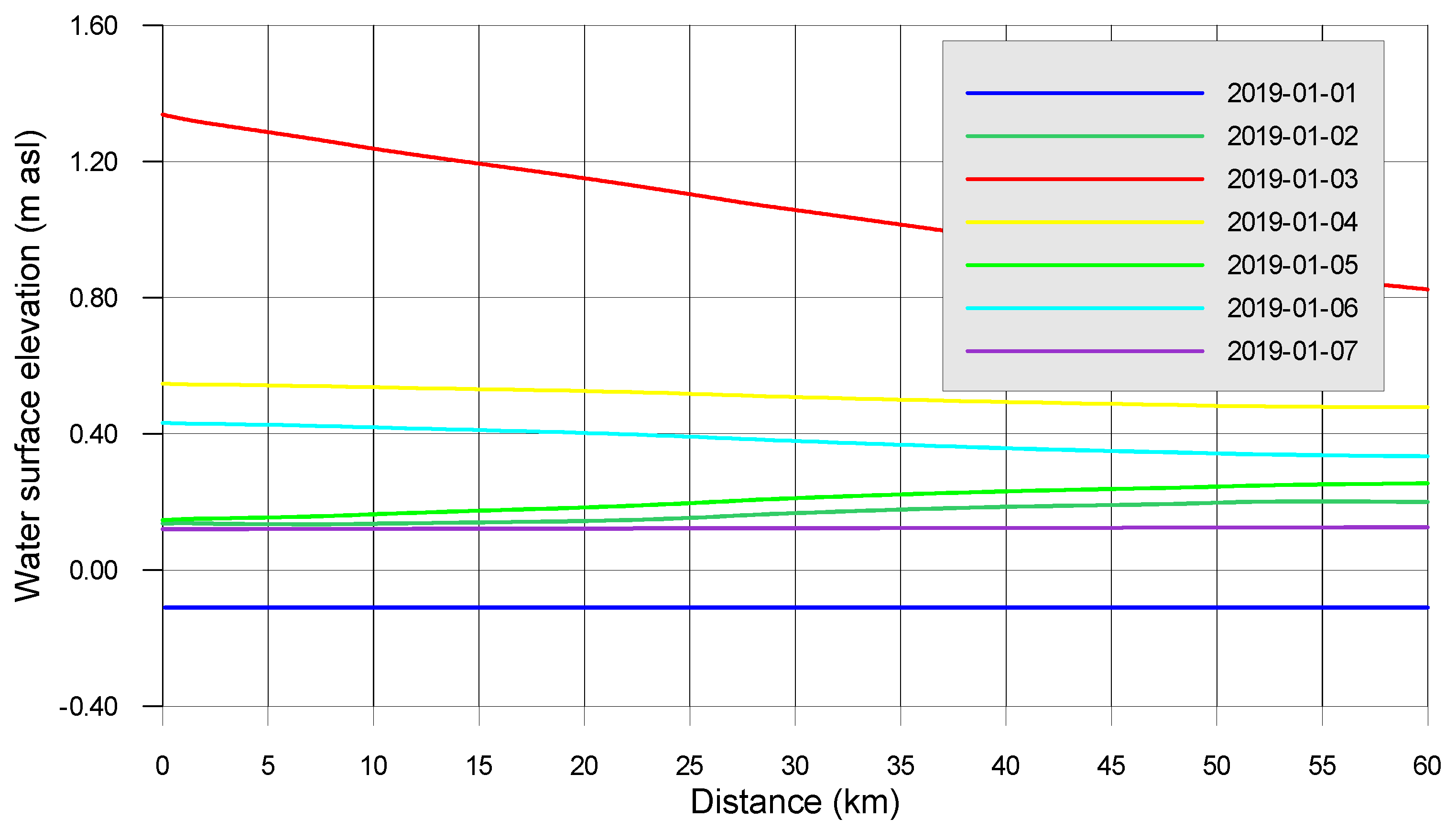
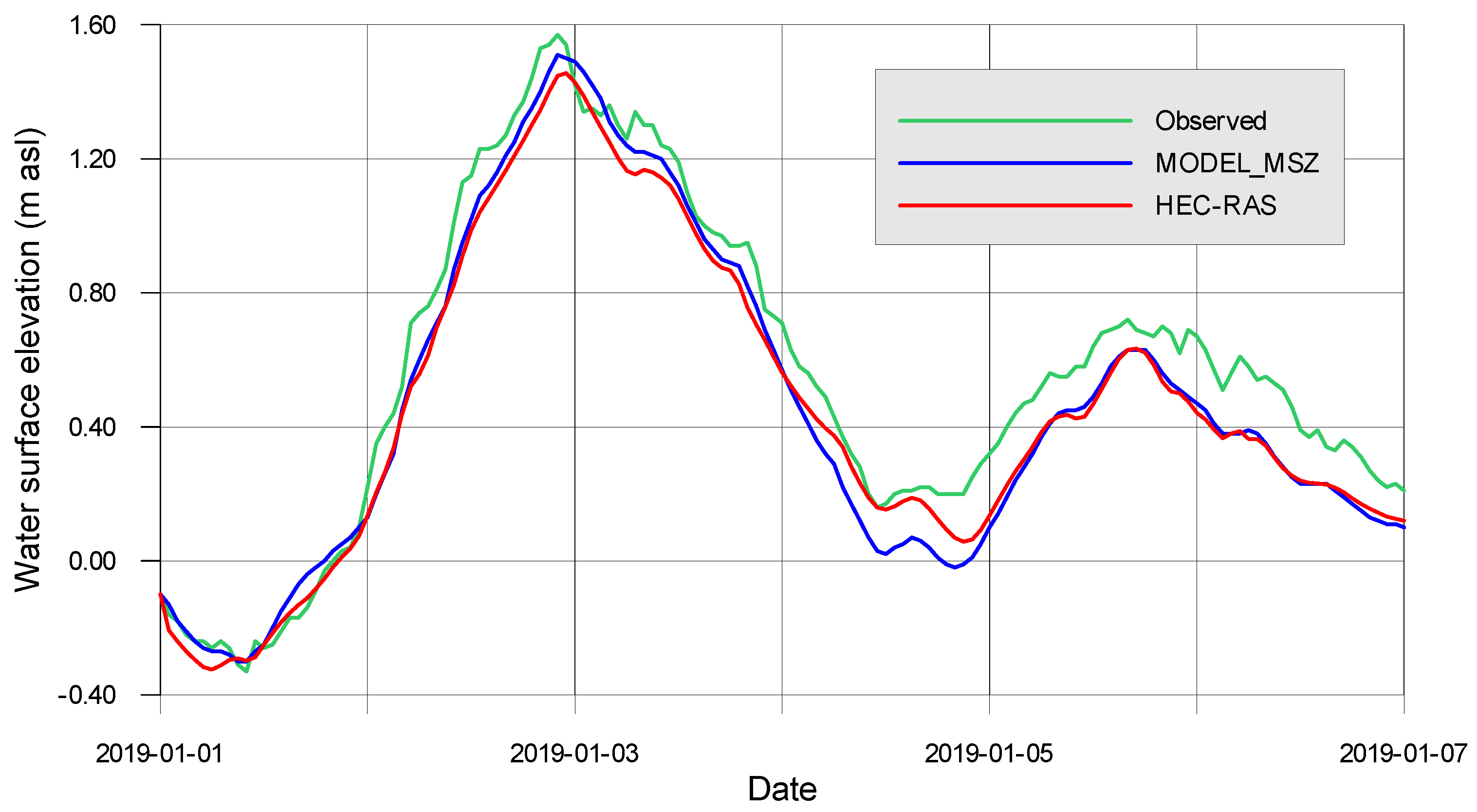

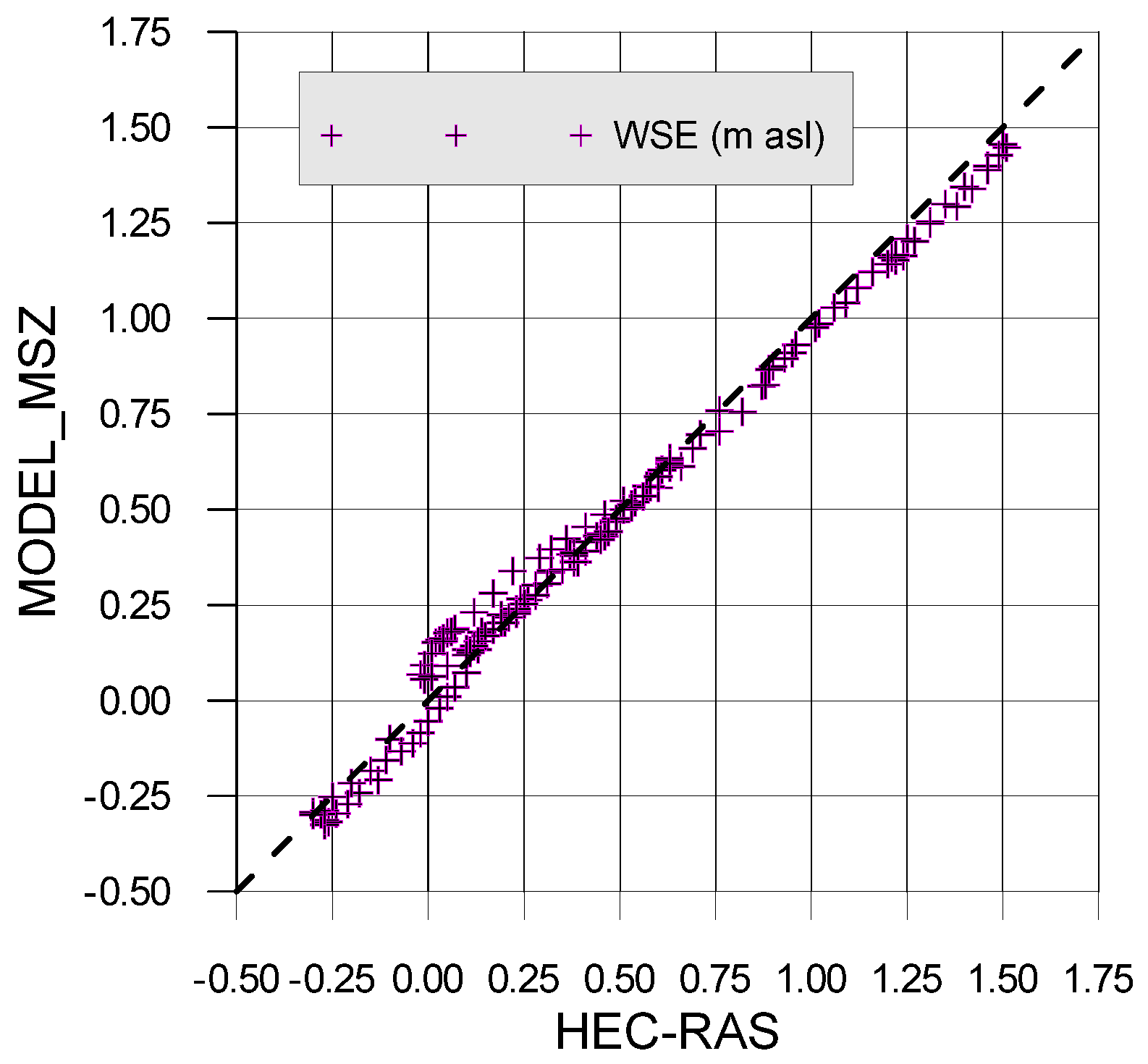
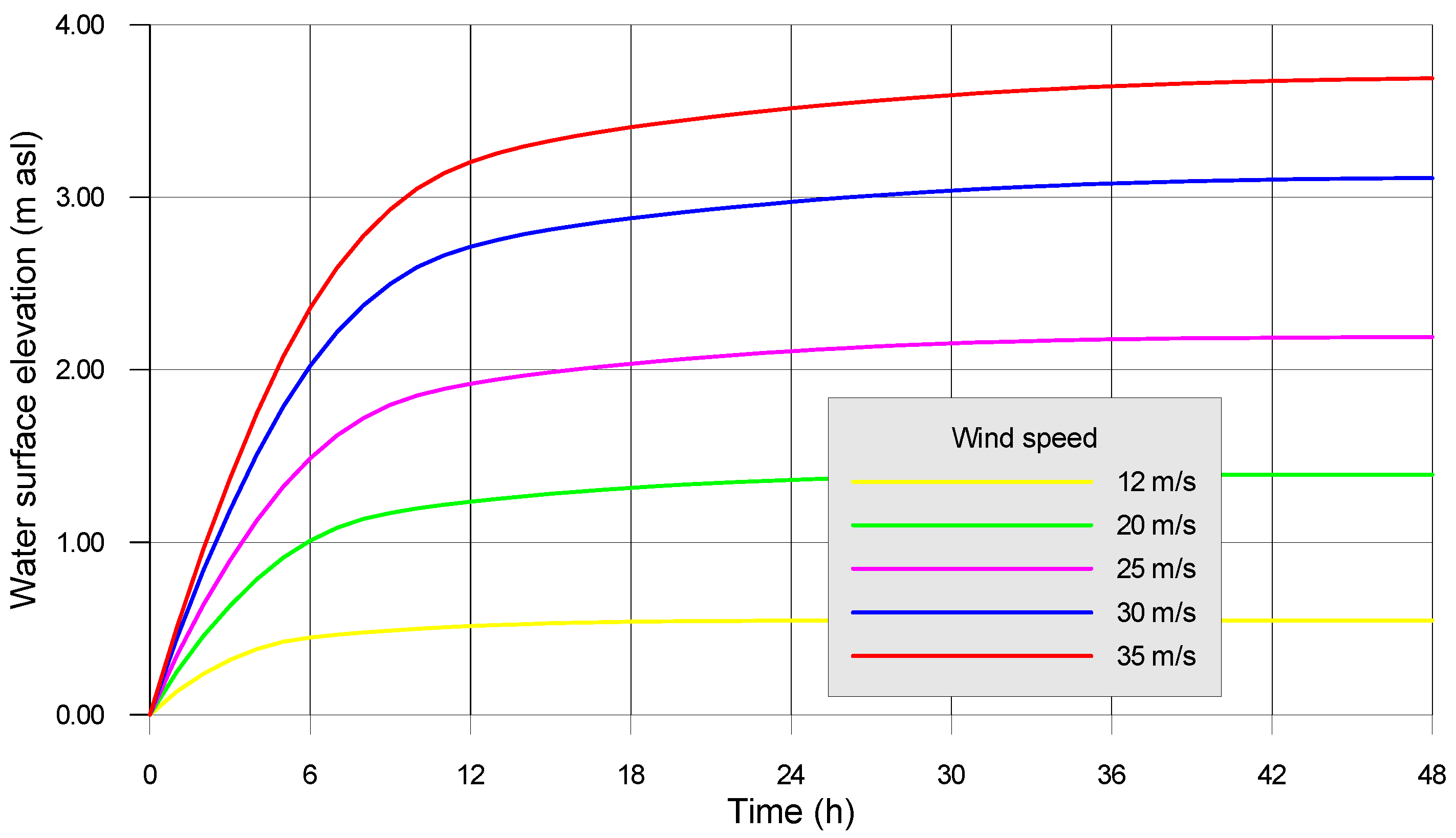
| Metric | Model_MSZ | Model_HEC_RAS |
|---|---|---|
| MAE (m) | 0.1126 | 0.1088 |
| RMSE (m) | 0.1283 | 0.1243 |
| NSE | 0.9300 | 0.9343 |
| Bias (m) | −0.0994 | −0.1051 |
| Speed of NE Wind (ms−1) | 12 | 20 | 25 | 30 | 35 |
|---|---|---|---|---|---|
| Water stage elevation (m asl) | 0.55 | 1.40 | 2.19 | 3.12 | 3.69 |
Disclaimer/Publisher’s Note: The statements, opinions and data contained in all publications are solely those of the individual author(s) and contributor(s) and not of MDPI and/or the editor(s). MDPI and/or the editor(s) disclaim responsibility for any injury to people or property resulting from any ideas, methods, instructions or products referred to in the content. |
© 2025 by the authors. Licensee MDPI, Basel, Switzerland. This article is an open access article distributed under the terms and conditions of the Creative Commons Attribution (CC BY) license (https://creativecommons.org/licenses/by/4.0/).
Share and Cite
Szydłowski, M.; Galata, A.W.; Gulshad, K. Preliminary Prediction of the Increase in Flood Hazard from Wind Surges for the City of Elbląg Due to Climate Change. Appl. Sci. 2025, 15, 5654. https://doi.org/10.3390/app15105654
Szydłowski M, Galata AW, Gulshad K. Preliminary Prediction of the Increase in Flood Hazard from Wind Surges for the City of Elbląg Due to Climate Change. Applied Sciences. 2025; 15(10):5654. https://doi.org/10.3390/app15105654
Chicago/Turabian StyleSzydłowski, Michał, Abdata Wakjira Galata, and Khansa Gulshad. 2025. "Preliminary Prediction of the Increase in Flood Hazard from Wind Surges for the City of Elbląg Due to Climate Change" Applied Sciences 15, no. 10: 5654. https://doi.org/10.3390/app15105654
APA StyleSzydłowski, M., Galata, A. W., & Gulshad, K. (2025). Preliminary Prediction of the Increase in Flood Hazard from Wind Surges for the City of Elbląg Due to Climate Change. Applied Sciences, 15(10), 5654. https://doi.org/10.3390/app15105654








